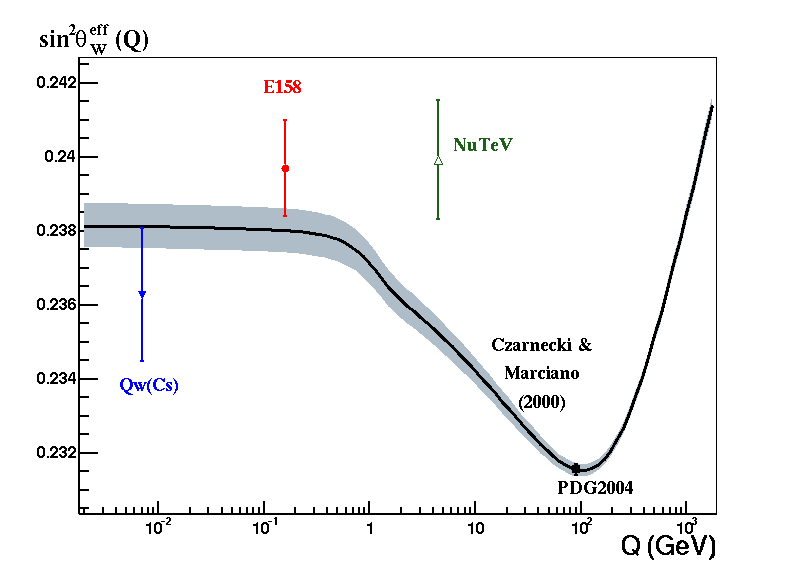|
The primary physics result for the
E158 experiment is the measurement of
parity violation in electron-electron scattering. This
measurement is used to determine the electron's weak charge and the weak
mixing angle parameter, sin2qWeff,
at low momentum transfer, Q. E158 measures the weak mixing angle parameter to be
0.2397 ± 0.0014. This is 4% greater than
the result at high energy obtained from the
SLD and
LEP experiments, demonstrating the
"running" of the weak mixing angle with a significance
of 6.2 standard deviations.
The electron's weak charge is approximately
given by QW(e) = -(1-4sin2qWeff).
E158 finds QW(e) = -0.041
± 0.006,
approximately ½ the value expected if there were no
running!
The following plot
summarizes E158's measurement of the weak mixing angle parameter and its
"running" with momentum scale.
More details of E158's measurement and analysis can be found
here.

The E158 weak mixing angle result is shown here, together
with results from other experiments and a
theoretical prediction (black
curve) from Czarnecki and Marciano. The gray region about the
black theory curve represents the theoretical uncertainty in the
"running" (evolution) of the weak mixing angle from the Z0
mass energy scale of the
SLD and
LEP experiments to low energy.
The result is consistent with the Standard Model
(SM)
Prediction. In addition to the results from SLAC E158 and the SLD
and LEP experiments, we also plot low energy results from an Atomic
Parity Violation (APV) experiment using Cesium,
QW(Cs), and a neutrino-nucleon
scattering experiment,
NuTeV. The APV experiment was carried out
by a group at Boulder, Colorado and the NuTeV experiment was performed
at Fermilab. The APV result is from data taken in the 1990s, and
as recently as 2000 indicated a discrepancy of 2.5
standard deviations
with the Standard Model predictions. Since 2000,
improved atomic theory calculations indicate the discrepancy to be
within 1 standard deviation of the SM prediction. The NuTeV
result, however, disagrees with the SM prediction by 3 standard
deviations. Studies are ongoing to check for contributions and
uncertainties from "conventional" effects -- strong and electroweak radiative corrections, isospin symmetry violation or an asymmetric
strange sea. A distinct advantage for the E158 experiment is that
the theoretical prediction is quite precise because of the simple
electron-electron scattering process.
Implications and Limits on New Physics, Beyond the Standard Model
The parity-violating asymmetry measured by
E158 arises from interference between photon and Z exchange interactions
in electron-electron scattering (see
illustration). The precision of the experimental result makes
it sensitive to additional interference effects from Z' particles
postulated in theories with supersymmetry, extra dimensions and unified
forces. The consistency of E158's result with SM predictions imply
that the mass of such Z' particles be greater than 1000 GeV, more than 10
times the mass of the Z particle. Stringent limits can be also be
set on a compositeness scale describing the binding energy of new
constituent particles that comprise the known leptons (such as
electrons) and quarks. The E158 result sets a limit on the
compositeness scale describing electron substructure to be 10 TeV (10,
000 GeV) or greater.
|

